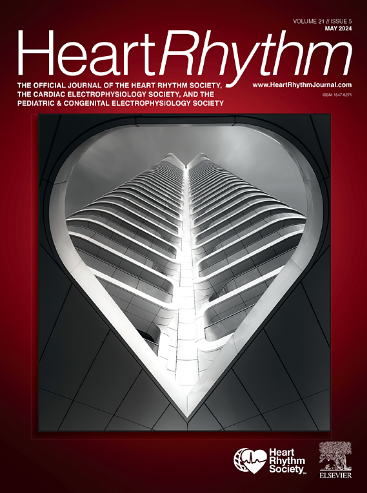Specific locations of myocardial inflammation and fibrosis are associated with higher risk of events in cardiac sarcoidosis
IF 5.6
2区 医学
Q1 CARDIAC & CARDIOVASCULAR SYSTEMS
引用次数: 0
Abstract
Background
18F-Fluorodeoxyglucose (18F-FDG) positron emission tomography (PET)/magnetic resonance (MR) can identify inflammation and fibrosis, which are high-risk features in cardiac sarcoidosis.
Objective
The purpose of this study was to evaluate whether the involvement of certain myocardial segments is associated with higher risk compared to others.
Methods
One hundred twenty-four patients with suspected clinical sarcoidosis underwent 18F-FDG-PET/MR. Late gadolinium enhancement (LGE) and focal 18F-FDG uptake were evaluated globally and in the 16 myocardial segments. Presence of LGE was defined when the percentage of LGE exceeded 5.7% globally (relative to myocardial volume) and in each myocardial segment. Patients were followed up for 5.5 years. Events were defined as ventricular arrhythmia (VA) (including sustained ventricular tachycardia, ventricular fibrillation, and appropriate implantable cardioverter-defibrillator discharge), heart failure hospitalization, or all-cause death.
Results
Mean age was 57.1 ± 8.9 years, and 39.5% were female. Twenty-two patients (17.6%) had an event during follow-up, and 9 (7.2%) presented with VA. LGE and 18F-FDG uptake were more frequent in patients with than without events (36.4% vs 7.8%, P = .001). Presence of LGE and 18F-FDG in the basal anterior segment were independent predictors for events after adjustment for left ventricular ejection fraction and relative enhanced volume (LGE: odds ratio [1.2–92.4], P = .034;18F-FDG: odds ratio 5.5 [1.1–27.5], P = .038). LGE presence in basal to mid-anterior, mid-anteroseptal, and basal to mid-inferoseptal segments was an independent predictor of VA. Presence of 18F-FDG in basal to mid-anterior, mid-inferoseptal and mid-inferior segments was an independent predictor of VA.
Conclusion
Involvement of specific myocardial segments, particularly basal to mid-anterior and mid-septal segments, is associated with higher rates of events in patients with suspected cardiac sarcoidosis.
特定部位的心肌炎症和纤维化与心脏肉样瘤病的高发病风险有关。
背景:18F-FDG-PET/MR可识别炎症和纤维化,这是心脏肉样瘤病的高危特征:方法:124 名疑似临床肉样瘤病患者接受了 18F-FDG-PET/MR 检查。方法:124 名临床疑似肉样瘤病患者接受了 18F-FDG-PET/MR 检查,对整体和 16 个心肌节段的晚期钆增强(LGE)和局灶性 18F-FDG 摄取进行了评估。当全球(相对于心肌体积)和每个心肌节段的 LGE 百分比超过 5.7% 时,即定义为存在 LGE。对患者进行了长达 5.5 年的随访。事件定义为室性心律失常(VA,包括持续性室性心动过速、心室颤动和适当的 ICD 出院)、心力衰竭住院或全因死亡:平均年龄为(57.1±8.9)岁,女性占 39.5%;22 名患者(17.6%)在随访时发生了心律失常,9 名患者(7.2%)出现了室速。与未发生事件的患者相比,发生 LGE 和 18F-FDG 摄取的患者更多(36.4% 对 7.8%,P=0.001)。根据左心室射血分数和相对增强容积进行调整后,基底前段出现 LGE 或 18F-FDG 是独立的事件预测因子(LGE:OR 10.5[1.2-92.4];p=0.034;18F-FDG:OR 5.5[1.1-27.5],p=0.038)。基底至前中段、前隐中段和基底至后隐中段出现 LGE 是 VA 的独立预测因素。18F-FDG出现在基底至前中段、前隐窝中段和下隐窝中段是VA的独立预测因素:结论:在疑似心脏肉样瘤病患者中,特定心肌节段(尤其是前中段基底和隔中段)的受累与较高的事件发生率相关。
本文章由计算机程序翻译,如有差异,请以英文原文为准。
求助全文
约1分钟内获得全文
求助全文
来源期刊

Heart rhythm
医学-心血管系统
CiteScore
10.50
自引率
5.50%
发文量
1465
审稿时长
24 days
期刊介绍:
HeartRhythm, the official Journal of the Heart Rhythm Society and the Cardiac Electrophysiology Society, is a unique journal for fundamental discovery and clinical applicability.
HeartRhythm integrates the entire cardiac electrophysiology (EP) community from basic and clinical academic researchers, private practitioners, engineers, allied professionals, industry, and trainees, all of whom are vital and interdependent members of our EP community.
The Heart Rhythm Society is the international leader in science, education, and advocacy for cardiac arrhythmia professionals and patients, and the primary information resource on heart rhythm disorders. Its mission is to improve the care of patients by promoting research, education, and optimal health care policies and standards.
 求助内容:
求助内容: 应助结果提醒方式:
应助结果提醒方式:


